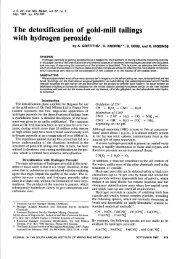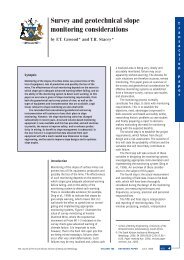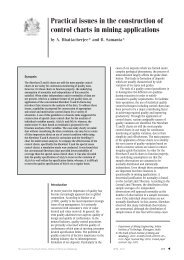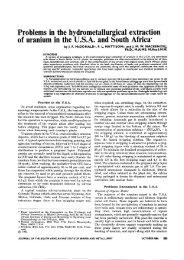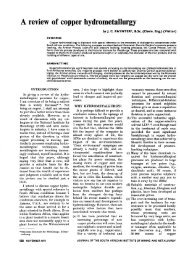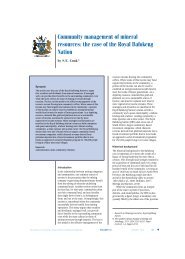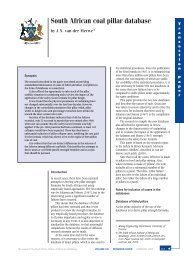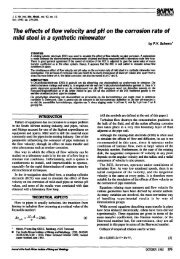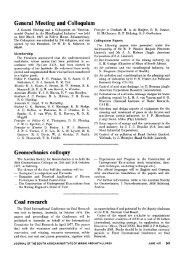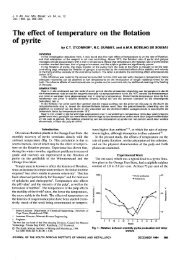and slag in the submerged-arc furnace - saimm
and slag in the submerged-arc furnace - saimm
and slag in the submerged-arc furnace - saimm
You also want an ePaper? Increase the reach of your titles
YUMPU automatically turns print PDFs into web optimized ePapers that Google loves.
The mode of current transfer between electrode<br />
.<br />
<strong>and</strong> <strong>slag</strong> <strong>in</strong> <strong>the</strong> <strong>submerged</strong>-<strong>arc</strong> <strong>furnace</strong><br />
SYNOPSIS<br />
by W. P. CHANNON*, B.Sc.(Eng.)(Student Member),<br />
R. C. URQUHARTt, M.Sc.(Eng.), ;'h.D.(Visitor),<br />
<strong>and</strong> D. D. HOWAT*, B.Sc., Ph.D.(Fellow)<br />
An account is given of a laboratory experiment <strong>in</strong> which <strong>the</strong> resistivity of a primary <strong>slag</strong> like those produced <strong>in</strong> <strong>the</strong><br />
manufacture of high-carbon ferrochromium was measured at current densities typical of operation <strong>in</strong> a <strong>submerged</strong><strong>arc</strong><br />
<strong>furnace</strong>. It was shown that <strong>the</strong> current flow from graphite electrode to molten <strong>slag</strong> obeys Ohm's Law when<br />
electrode current densities are less than 12 A/cm". At higher current densities, <strong>arc</strong><strong>in</strong>g occurs from <strong>the</strong> electrode<br />
tip to <strong>the</strong> <strong>slag</strong>, caus<strong>in</strong>g an imbalance <strong>in</strong> <strong>the</strong> rate of heat<strong>in</strong>g <strong>in</strong> <strong>the</strong> <strong>furnace</strong> burden.<br />
SAMEVATTING<br />
In <strong>the</strong> last twenty years several<br />
dramatic changes have occurred <strong>in</strong><br />
<strong>the</strong> field of high-temperature smelt<strong>in</strong>g.<br />
One of <strong>the</strong>se changes was <strong>the</strong><br />
<strong>in</strong>troduction of electric power for<br />
<strong>the</strong> generation of high temperatures,<br />
<strong>in</strong> place of fossil fuels. The<br />
ever-<strong>in</strong>creas<strong>in</strong>g shortage of cok<strong>in</strong>g<br />
coal has resulted <strong>in</strong> <strong>the</strong> <strong>submerged</strong><strong>arc</strong><br />
<strong>furnace</strong> becom<strong>in</strong>g a valuable<br />
metallurgical tool for <strong>the</strong> production<br />
of ferro-alloys. The energy requirements<br />
for <strong>the</strong> production of ferroalloys<br />
vary from 2 to 10 MWh per<br />
tonne of alloy produced, <strong>and</strong> <strong>the</strong><br />
cost of electric power is sufficiently<br />
high for economy of operation to<br />
be essential.<br />
It has been ma<strong>in</strong>ta<strong>in</strong>ed that <strong>the</strong><br />
production from electric reduction<br />
<strong>furnace</strong>s is a direct function of <strong>the</strong><br />
resistance of <strong>the</strong> burden <strong>in</strong> <strong>the</strong><br />
<strong>furnace</strong>1. The heat<strong>in</strong>g <strong>in</strong>a ferroalloy<br />
<strong>furnace</strong> is not uniform because<br />
<strong>the</strong> constituents of <strong>the</strong> burden<br />
undergo physical <strong>and</strong> chemical<br />
alteration as <strong>the</strong>y progress down<br />
through <strong>the</strong> <strong>furnace</strong>. This has motivated<br />
studies on <strong>the</strong> variation, with<br />
temperature, of <strong>the</strong> electrical resistivity<br />
of <strong>the</strong> <strong>in</strong>dividual burden components,<br />
of <strong>the</strong> mixed burden components,<br />
<strong>and</strong> of <strong>the</strong> molten <strong>slag</strong>1-7.<br />
In addition, it has been shown that<br />
<strong>the</strong> major proportion of <strong>the</strong> power<br />
<strong>in</strong> a <strong>submerged</strong>-<strong>arc</strong> <strong>furnace</strong> is dissi-<br />
*University of <strong>the</strong> Witwatersr<strong>and</strong>.<br />
tNIM Pyrometallurgical Rese<strong>arc</strong>h<br />
Group, University of <strong>the</strong> Witwatersr<strong>and</strong>.<br />
4 AUGUST 1974<br />
Daar word ver<strong>slag</strong> gedoen ocr 'n laboratoriumeksperiment waar<strong>in</strong> die spesifieke weerst<strong>and</strong> van 'n primere slak<br />
secs dill wat <strong>in</strong> die vervaardig<strong>in</strong>g van koolryke ferrochroom verkry word, gemeet is by stroomdig<strong>the</strong>de wat tipies is<br />
van werk<strong>in</strong>g <strong>in</strong> 'n dampelboogoond. Daar is getoon dat die stroomvloei van die grafietelektrode na die gesmelte<br />
slak die Wet van Ohm gehoorsaam wanneer die elektrode se stroomdig<strong>the</strong>id m<strong>in</strong>der as 12 A/cm" is. By hoer stroomdig<strong>the</strong>de<br />
v<strong>in</strong>d daar oor<strong>slag</strong> van die elektrodepunt na die slak plaas wat 'n wanbalans <strong>in</strong> die verhitt<strong>in</strong>gstempo van die<br />
oondlad<strong>in</strong>g veroorsaak.<br />
pated <strong>in</strong> <strong>the</strong> region of <strong>the</strong> tips of <strong>the</strong><br />
electrodes8. However, a certa<strong>in</strong><br />
amount of confusion seems to exist<br />
about <strong>the</strong> manner <strong>in</strong> which this<br />
power is dissipated. Some authors9,1o<br />
claim that <strong>the</strong> heat<strong>in</strong>g is ma<strong>in</strong>ly<br />
resistive, whereas o<strong>the</strong>rs favour <strong>the</strong><br />
<strong>the</strong>ory that <strong>the</strong> ma<strong>in</strong> heat is generated<br />
<strong>in</strong> <strong>the</strong> <strong>arc</strong> zone at <strong>the</strong> tips of<br />
<strong>the</strong> electrodesll.<br />
EXPERIMENTAL<br />
INVESTIGATION<br />
In order to <strong>in</strong>vestigate <strong>the</strong> mechanism<br />
of current transfer from<br />
electrode to molten <strong>slag</strong>, a simple<br />
experiment was designed to measure<br />
<strong>the</strong> resistivity of <strong>the</strong> <strong>slag</strong> at current<br />
densities typical of operation <strong>in</strong> a<br />
<strong>submerged</strong>-<strong>arc</strong> <strong>furnace</strong>. In a s<strong>in</strong>glephase<br />
circuit, current at 50 Hz<br />
frequency was made to flow via a<br />
graphite electrode through a primary<br />
<strong>slag</strong> typical of those produced <strong>in</strong> <strong>the</strong><br />
manufacture of high-carbon ferrochromium<br />
(22 per cent MgO, 28 per<br />
cent A12O3' 50 per cent SiO2, saturated<br />
<strong>in</strong> carbon). The experimental<br />
apparatus is shown <strong>in</strong> Fig. 1. The<br />
current density on <strong>the</strong> graphite<br />
electrode could be varied between<br />
0 <strong>and</strong> 15 Afcm2, <strong>the</strong> graphite crucible<br />
act<strong>in</strong>g as <strong>the</strong> second electrode.<br />
Experiments were performed <strong>in</strong> a<br />
molybdenum-wound resistance <strong>furnace</strong><br />
at <strong>slag</strong> temperatures <strong>in</strong> <strong>the</strong><br />
region of 1500 DC. The voltage across<br />
<strong>and</strong> <strong>the</strong> current flow<strong>in</strong>g through <strong>the</strong><br />
molten <strong>slag</strong> were observed on an<br />
oscilloscope screen. The graphite<br />
electrode <strong>and</strong> crucible were pro-<br />
tected aga<strong>in</strong>st oxidation by purg<strong>in</strong>g<br />
of <strong>the</strong> system with argon gas. At<br />
electrode current densities of less<br />
than 12 Afcm2, it was found that <strong>the</strong><br />
oscilloscope trace of <strong>the</strong> current<br />
flow pattern was s<strong>in</strong>usoidal <strong>and</strong><br />
Ohm's Law obta<strong>in</strong>ed. Figs. 2 (a) <strong>and</strong><br />
(b) show <strong>the</strong> form of <strong>the</strong> oscilloscope<br />
traces for <strong>the</strong> potential across <strong>the</strong><br />
<strong>slag</strong> <strong>and</strong> <strong>the</strong> current flow<strong>in</strong>g through<br />
it. However, it should be remembered<br />
that <strong>the</strong> magnitude of <strong>the</strong> <strong>slag</strong><br />
resistivity under <strong>the</strong>se '<strong>submerged</strong><strong>arc</strong><br />
<strong>furnace</strong>-like' conditions of high<br />
current density <strong>and</strong> low frequency is<br />
higher than <strong>the</strong> absolute resistivity<br />
as determ<strong>in</strong>ed <strong>in</strong> fundamental studies<br />
<strong>in</strong> <strong>the</strong> laboratory 6.<br />
At current densities <strong>in</strong> excess of<br />
12 Afcm2, <strong>the</strong> pattern of current<br />
flow as shown on <strong>the</strong> oscilloscope<br />
was characterized by <strong>the</strong> occurrence<br />
of unstable <strong>arc</strong><strong>in</strong>g. The voltage <strong>and</strong><br />
current waveforms typical of those<br />
obta<strong>in</strong>ed at current densities greater<br />
than 12 Afcm2 are illustrated <strong>in</strong><br />
Figs. 2 (c) <strong>and</strong> (d). As all <strong>the</strong> experiments<br />
were done with <strong>the</strong><br />
graphite electrode immersed <strong>in</strong> <strong>the</strong><br />
molten <strong>slag</strong>, <strong>the</strong> occurrence of <strong>arc</strong><strong>in</strong>g<br />
was at first puzzl<strong>in</strong>g. However, with<br />
<strong>the</strong> high current densities at <strong>the</strong> tip<br />
of <strong>the</strong> electrode, extreme localized<br />
heat<strong>in</strong>g occurs that leads to an<br />
<strong>in</strong>crease <strong>in</strong> <strong>the</strong> rate of reaction<br />
between <strong>the</strong> carbon electrode <strong>and</strong><br />
<strong>the</strong> <strong>slag</strong>, result<strong>in</strong>g <strong>in</strong> <strong>the</strong> formation<br />
of gaseous products, CO, <strong>and</strong> SiO.<br />
The rate of reduction of SiO2 to SiO<br />
by carbon is rapid at temperatures<br />
JOURNAL OF THE SOUTH AFRICAN INSTITUTE OF MINING AND METALLURGY
Argon<br />
2<br />
3<br />
4<br />
5<br />
Cl<br />
7<br />
JL<br />
Fig. I-The apparatus used <strong>in</strong> <strong>the</strong> ex.<br />
perimental determ<strong>in</strong>ations<br />
I Graphite rod<br />
2 S<strong>in</strong>danyo collar<br />
J Graphite spacer r<strong>in</strong>g<br />
4 Electrode<br />
5 Inner alum<strong>in</strong>a tube<br />
6 Furnace heat<strong>in</strong>g coils<br />
7 Outer alum<strong>in</strong>a tube<br />
8 Graphite crucible<br />
9 Graphite support rod<br />
10 Alum<strong>in</strong>a <strong>the</strong>rmocouple sheath<br />
II S<strong>in</strong>danyo disc<br />
12 Support collar<br />
greater than 1500oC12, <strong>and</strong> confirmation<br />
of this mechanism was<br />
obta<strong>in</strong>ed by <strong>the</strong> presence of a precipitated<br />
film of silica <strong>in</strong> <strong>the</strong> upper<br />
regions of <strong>the</strong> experimental <strong>furnace</strong>.<br />
The electric circuit for <strong>the</strong> system<br />
under <strong>arc</strong><strong>in</strong>g conditions is shown <strong>in</strong><br />
Fig. 3. As shown <strong>in</strong> Fig. 2 (c), <strong>the</strong><br />
voltage waveform represents <strong>the</strong><br />
total voltage drop across <strong>the</strong> series<br />
comb<strong>in</strong>ation of <strong>the</strong> <strong>arc</strong> <strong>and</strong> <strong>slag</strong><br />
resistance, that is, <strong>the</strong> sum of <strong>the</strong><br />
square wave voltage drop across <strong>the</strong><br />
<strong>arc</strong> <strong>and</strong> <strong>the</strong> s<strong>in</strong>e wave voltage drop<br />
across <strong>the</strong> <strong>slag</strong> resistance. The<br />
9<br />
(J)<br />
...,<br />
.-j<br />
D<br />
:::0<br />
50<br />
40<br />
30<br />
20<br />
10<br />
-10<br />
-20<br />
-30<br />
-40<br />
8<br />
6<br />
4<br />
2<br />
(J)<br />
CD<br />
1-1<br />
CD<br />
0-<br />
E<br />
et:<br />
- 2<br />
- 4<br />
- 6<br />
(J)<br />
...,<br />
.-j<br />
D<br />
:::0<br />
(J)<br />
CD<br />
1-1<br />
CD<br />
0-<br />
E<br />
et:<br />
30<br />
20<br />
10<br />
-10<br />
-20<br />
6<br />
- 6<br />
(a)<br />
(c)<br />
(d)<br />
seconds<br />
Fig. 2-Waveforms obta<strong>in</strong>ed for conduction experiments <strong>in</strong> <strong>the</strong> <strong>slag</strong> medium<br />
(a) S<strong>in</strong>usoidal voltage drop across <strong>slag</strong> resistance.<br />
(b) S<strong>in</strong>usoidal current now<strong>in</strong>g through <strong>the</strong> <strong>slag</strong>. The current lags <strong>the</strong> voltage by<br />
18°.<br />
(c) Voltage drop across <strong>the</strong> <strong>arc</strong> <strong>and</strong> <strong>the</strong> <strong>slag</strong> resistance.<br />
(d) Arc<strong>in</strong>g current <strong>and</strong> <strong>the</strong>oretically predicted <strong>arc</strong><strong>in</strong>g current.<br />
voltage trace is characterized by a<br />
sharp rise to <strong>the</strong> peak voltage required<br />
to re-ignite <strong>the</strong> <strong>arc</strong> (et). As<br />
soon as <strong>the</strong> <strong>arc</strong> strikes, current flow<br />
is re. established <strong>and</strong> <strong>the</strong> voltage<br />
drops to <strong>the</strong> <strong>arc</strong> voltage (ea), which<br />
rema<strong>in</strong>s constant for <strong>the</strong> rema<strong>in</strong>der<br />
of <strong>the</strong> half cycle. The s<strong>in</strong>usoidal cap<br />
on <strong>the</strong> voltage trace represents <strong>the</strong><br />
voltage drop across <strong>the</strong> <strong>slag</strong> resistance.<br />
It is of <strong>in</strong>terest at this po<strong>in</strong>t to<br />
call attention to <strong>the</strong> fact that, <strong>in</strong><br />
Figs. 2 (c) <strong>and</strong> (d), <strong>the</strong> ignition <strong>and</strong><br />
<strong>arc</strong> voltage, as well as <strong>the</strong> current,<br />
differ <strong>in</strong> each half cycle. This effect<br />
is primarily due to <strong>the</strong> differences <strong>in</strong><br />
cathode behaviour of <strong>the</strong> graphite<br />
electrode <strong>and</strong> <strong>the</strong> <strong>slag</strong> surface as <strong>the</strong><br />
polarity reverses with <strong>the</strong> alternat.<br />
<strong>in</strong>g current. Dur<strong>in</strong>g <strong>the</strong> second halfcycle,<br />
when <strong>the</strong> graphite electrode<br />
was <strong>the</strong> cathode, <strong>the</strong> <strong>arc</strong> conductivity<br />
was superior as shown by <strong>the</strong> lower<br />
<strong>arc</strong> voltage <strong>and</strong> higher current. This<br />
is <strong>in</strong> agreement with a similar f<strong>in</strong>d<strong>in</strong>g<br />
JOURNAL OF THE SOUTH AFRICAN INSTITUTE OF MINING AND METALLURGY AUGUST 1974 5<br />
2
_I<br />
Graphite<br />
Electrode<br />
-<br />
.~. ~~<br />
(a)<br />
-::-:::-- ~~-~=<br />
?- --- :. --- .- -r~olten --<br />
51ag<br />
5io co e a<br />
~<br />
- .~ It~~<br />
- - ...----- .---<br />
--- - -- - -<br />
C + 5i02 - CO+ 5io<br />
(b)<br />
Il..<br />
es<br />
Av<br />
r s<br />
f:aood~<br />
x r<br />
am "O<br />
x r<br />
~ ~:<br />
Fig. 3-A schematic diagram illustrat<strong>in</strong>g <strong>the</strong> two possible means of conduction<br />
(a) Ohmic conduction as shown by <strong>the</strong> equivalent circuit <strong>and</strong> <strong>the</strong> s<strong>in</strong>usoidal voltage<br />
drop across <strong>the</strong> <strong>slag</strong> resistance.<br />
(b) The equivalent circuit under conditions of <strong>arc</strong><strong>in</strong>g <strong>and</strong> <strong>the</strong> correspond<strong>in</strong>g<br />
voltage drop across <strong>the</strong> <strong>arc</strong> <strong>and</strong> <strong>slag</strong> resistance.<br />
by Schwabe13 <strong>and</strong> Bowman et al.14<br />
concern<strong>in</strong>g open-<strong>arc</strong> steel-melt<strong>in</strong>g<br />
<strong>furnace</strong>s.<br />
The equation describ<strong>in</strong>g <strong>the</strong> <strong>arc</strong><strong>in</strong>g<br />
circuit of Fig. 3 is:<br />
<strong>and</strong><br />
4e+i R+ea=Em s<strong>in</strong> (wt-cp),<br />
where wt ~ cp<br />
cp=<strong>arc</strong> ignition angle with<br />
respect to <strong>the</strong> supplyvoltage<br />
zero cross<strong>in</strong>g,<br />
.<br />
-l.<br />
ei<br />
SIn .,.,=<br />
Em '<br />
L=<strong>the</strong> <strong>in</strong>ductance of <strong>the</strong><br />
circuit, <strong>and</strong><br />
R=<strong>the</strong> resistance of <strong>the</strong> <strong>slag</strong><br />
<strong>and</strong> circuit.<br />
In <strong>the</strong> case of open-<strong>arc</strong> steelmak<strong>in</strong>g<br />
<strong>furnace</strong>s, <strong>the</strong> voltage drop<br />
across <strong>the</strong> bus bar resistance (ir) is<br />
small compared with ea, <strong>and</strong> so this<br />
term is usually neglected <strong>in</strong> <strong>the</strong><br />
above equation. However, <strong>in</strong> <strong>the</strong><br />
<strong>submerged</strong>-<strong>arc</strong> equivalent, <strong>the</strong> voltage<br />
drop across <strong>the</strong> <strong>slag</strong> resistance<br />
is not <strong>in</strong>significant. A solution of <strong>the</strong><br />
above differential equation has been<br />
given as :15<br />
i= ~m {s<strong>in</strong> (wt-cp)-s<strong>in</strong> (cp-a)<br />
[ - R
12 A/cm2 determ<strong>in</strong>ed as <strong>the</strong> limit for<br />
ohmic conduction <strong>in</strong> this study. It is<br />
expected that this value would be<br />
larger than that for a production<br />
unit ow<strong>in</strong>g to higher heat losses from<br />
<strong>the</strong> laboratory system. However,<br />
areas of high current density may<br />
occur at <strong>the</strong> tip of <strong>the</strong> electrode, <strong>and</strong><br />
consequently an <strong>arc</strong> might be struck<br />
from <strong>the</strong> electrode to <strong>the</strong> <strong>slag</strong>. If<br />
an <strong>arc</strong> strikes from <strong>the</strong> tip of one<br />
electrode <strong>in</strong> a three-electrode <strong>submerged</strong>-<strong>arc</strong><br />
<strong>furnace</strong>, <strong>the</strong>n <strong>the</strong> resistance<br />
of this phase will be higher<br />
than that of <strong>the</strong> rema<strong>in</strong><strong>in</strong>g two<br />
phases, result<strong>in</strong>g <strong>in</strong> an unbalanced<br />
three-phase load. This imbalance <strong>in</strong><br />
<strong>the</strong> three-phase load will be fur<strong>the</strong>r<br />
aggravated by <strong>the</strong> difference <strong>in</strong> <strong>arc</strong><br />
resistance between <strong>the</strong> positive <strong>and</strong><br />
negative cycle. The power <strong>in</strong> <strong>the</strong><br />
<strong>arc</strong><strong>in</strong>g phase will be lower than <strong>in</strong><br />
<strong>the</strong> o<strong>the</strong>r two phases, <strong>and</strong>, as a<br />
consequence, <strong>the</strong> total power dissipated<br />
<strong>in</strong> <strong>the</strong> <strong>furnace</strong> will decrease.<br />
Although an imbalance <strong>in</strong> <strong>the</strong> threephase<br />
load is not detrimental to <strong>the</strong><br />
work<strong>in</strong>gs of <strong>the</strong> <strong>furnace</strong> transformer,<br />
it will result <strong>in</strong> uneven heat<strong>in</strong>g <strong>in</strong><br />
<strong>the</strong> <strong>furnace</strong> burden <strong>and</strong> this may<br />
cause difficulties <strong>in</strong> operation. On<br />
<strong>furnace</strong>s produc<strong>in</strong>g high-carbon<br />
ferrochromium, it has been observed<br />
that fluctuations of <strong>the</strong> voltage <strong>and</strong><br />
current meters may occur for short<br />
periods follow<strong>in</strong>g a <strong>furnace</strong> tap.<br />
This is probably caused by burden<br />
fall<strong>in</strong>g away from <strong>the</strong> tip of <strong>the</strong><br />
electrode <strong>and</strong> an <strong>arc</strong> be<strong>in</strong>g struck as a<br />
Iesult. Reactance meters, or similar<br />
devices that can detect changes <strong>in</strong><br />
phase angle, can be used to warn of<br />
<strong>the</strong> occurrence of <strong>arc</strong><strong>in</strong>g. The operator's<br />
reaction is to decrease <strong>the</strong> electrode-to-electrode<br />
voltage <strong>and</strong>/or to<br />
raise <strong>the</strong> electrode slightly. In short, a<br />
decrease <strong>in</strong> <strong>the</strong> voltage gradient will<br />
serve to ext<strong>in</strong>guish <strong>the</strong> <strong>arc</strong>.<br />
It seems that, <strong>in</strong> <strong>the</strong> design of<br />
<strong>submerged</strong>-<strong>arc</strong> <strong>furnace</strong>s, <strong>the</strong> current<br />
density <strong>in</strong> <strong>the</strong> electrode is chosen so<br />
that <strong>arc</strong><strong>in</strong>g <strong>in</strong> <strong>the</strong> <strong>furnace</strong> will be<br />
avoided. In Table I it appears that<br />
<strong>the</strong> permissible current density <strong>in</strong>creases<br />
as <strong>the</strong> endo<strong>the</strong>rmic nature of<br />
<strong>the</strong> reduction reactions <strong>in</strong>crease.<br />
The lower limit appears to occur for<br />
<strong>the</strong> smelt<strong>in</strong>g of copper-nickel concentrates<br />
<strong>in</strong> which <strong>the</strong>re is virtually<br />
no endo<strong>the</strong>rmic heat of reaction.<br />
Product<br />
TABLE I<br />
FeCrSi (S<strong>in</strong>gle step)<br />
FeCr (High carbon)<br />
FeMn (High carbon)<br />
CuNi matte. . . . .<br />
CONCLUSIONS<br />
Current density<br />
A/cm2<br />
6,5<br />
5,0<br />
4,0<br />
1,5<br />
The laboratory experiment has<br />
shown that current flow from a<br />
graphite electrode to a molten <strong>slag</strong><br />
obeys Ohm's Law at electrode<br />
current densities of less than 12<br />
A/cm2. With current densities <strong>in</strong><br />
excess of 12 A/cm2, <strong>arc</strong><strong>in</strong>g occurs<br />
from <strong>the</strong> electrode tip to <strong>the</strong> <strong>slag</strong>.<br />
Arc<strong>in</strong>g is not desirable <strong>in</strong> <strong>furnace</strong>s<br />
designed for resistance heat<strong>in</strong>g because<br />
it results <strong>in</strong> a decrease <strong>in</strong><br />
power delivered to <strong>the</strong> <strong>furnace</strong> at a<br />
given voltage. The strik<strong>in</strong>g of an<br />
<strong>arc</strong> from one electrode effectively <strong>in</strong>creases<br />
<strong>the</strong> resistance of that phase<br />
with respect to <strong>the</strong> o<strong>the</strong>rs, caus<strong>in</strong>g<br />
an imbalance <strong>in</strong> <strong>the</strong> rate of heat<strong>in</strong>g<br />
<strong>in</strong> <strong>the</strong> <strong>furnace</strong> burden. S<strong>in</strong>ce <strong>the</strong><br />
presence of an <strong>in</strong>ductive load <strong>in</strong> <strong>the</strong><br />
circuit, with its effect of decreas<strong>in</strong>g<br />
<strong>the</strong> power factor, tends to create<br />
conditions for stable <strong>arc</strong><strong>in</strong>g, large<br />
smelt<strong>in</strong>g units with <strong>the</strong>ir <strong>in</strong>herently<br />
low power factors may be subject to<br />
some <strong>arc</strong><strong>in</strong>g problems.<br />
ACKNOWLEDGEMENT<br />
The authors acknowledge <strong>the</strong> assistance<br />
of Mr R. de Kock, of <strong>the</strong><br />
Instruments Division of<strong>the</strong> National<br />
Institute for Metallurgy, who helped<br />
with <strong>the</strong> record<strong>in</strong>g of <strong>the</strong> oscilloscope<br />
waveforms.<br />
REFERENCES<br />
1. COR:aeA DA SILVEIRA, R. Electrical<br />
<strong>and</strong> metallurgical reasons for some<br />
charges employed <strong>in</strong> electrical reduction<br />
<strong>furnace</strong>s produc<strong>in</strong>g ferro-alloys.<br />
JOURNAL OF THE SOUTH AFRICAN INSTITUTE OF MINING AND METALLURGY<br />
Metalllurgia A.B.M., vo!. 25, no. 136.<br />
1969. pp. 167.178.<br />
2. VOLKERT, G. Influence of <strong>slag</strong> composition<br />
on <strong>the</strong> operational characteristics<br />
of an electric reduction <strong>furnace</strong>.<br />
Chemie Ingenieur Technik, vo!. 42,<br />
no. 4. 1970. pp. 218-221.<br />
3. LIUTIKOV, L. A., <strong>and</strong> TsYLEv, L. M.<br />
Viscosity <strong>and</strong> electrical conductivity<br />
of MgO-Al.O3-SiO. melts. Izv. Akad.<br />
Nauk. S.S.S.R. Old. Tekn. Nauk.<br />
MetaU.i.Gorn. Delo, no. 1. 1963.<br />
pp. 41-52.<br />
4. LIUTIKOV, L. A., <strong>and</strong> TsYLEv, L. M.<br />
Effect of chromium oxide on <strong>the</strong><br />
viscosity <strong>and</strong> electrical conductivity<br />
of melts of <strong>the</strong> MgO-Al.O3-SiO.<br />
system. Ibid., no. 2. 1963. pp. 59-66.<br />
5. OSSIN, D. 1., et al. Liquidus temperatures,<br />
viscosities <strong>and</strong> electrical conductivities<br />
of lime-conta<strong>in</strong><strong>in</strong>g <strong>slag</strong>s<br />
produced dur<strong>in</strong>g <strong>the</strong> smelt<strong>in</strong>g of<br />
high-carbon ferrochromium <strong>and</strong> ferrochromium-silicide<br />
alloys. 29th Electrical<br />
Furnace Conference, 1971. pp.<br />
94-101.<br />
6. RENNIE, M. S., et al. The effects of<br />
chromium oxide, iron oxide, <strong>and</strong><br />
calcium oxide on <strong>the</strong> liquidus temperatures,<br />
viscosities <strong>and</strong> electrical<br />
conductivities of <strong>slag</strong>s <strong>in</strong> <strong>the</strong> system<br />
MgO-Al.O3-SiO.. J. S.Afr. Inst. M<strong>in</strong>.<br />
MetaU., vo!. 73, no. 1. Aug. 1972.<br />
pp. 1-9.<br />
7. DOWNING, J. H., <strong>and</strong> URBAN, L.<br />
Electrical conduction <strong>in</strong> <strong>submerged</strong><strong>arc</strong><br />
<strong>furnace</strong>s. J. Metals, Mar. 1966.<br />
pp. 337-344.<br />
8. URQUHART, R. C., et al. The dissipation<br />
of e]ectrical power <strong>in</strong> <strong>the</strong> burden<br />
of a <strong>submerged</strong>-<strong>arc</strong> <strong>furnace</strong>. 31st Electric<br />
Furnace Conference, 1973.<br />
9. ELYUTIN, V. P., et al. Production of<br />
ferro-alloys. ElectrometaUurgy, 2nd<br />
edition, Israel Program for Scientific<br />
Translations. Jerusalem, 1957.<br />
10. PASCHKIS, V., <strong>and</strong> PERSSON, J.<br />
Industrial electric <strong>furnace</strong>s <strong>and</strong> appliances.<br />
New York, Interscience Publishers,<br />
1960.<br />
11. VOLKERT, G., <strong>and</strong> FRANK, K.-D.<br />
MetaUurgie der ferrolegierungen. 2.<br />
Neubearbeitete una erueiterte auflage.<br />
Berl<strong>in</strong>, Spr<strong>in</strong>ger-Verlag, 1972.<br />
12. KLINGER, N., et al. Reactions between<br />
silica <strong>and</strong> graphite. J. Amer. Cer.<br />
Soc., vo!. 49. 1966. pp. 369-375.<br />
13. SCHWABE,W. E. Measur<strong>in</strong>g problems<br />
<strong>and</strong> techniques at A-C <strong>furnace</strong> <strong>arc</strong>s.<br />
J. Electchem. Soc., vo!. 101. 1954.<br />
pp. 554-559.<br />
14. BOWMAN, B., et al. The physics of<br />
high current <strong>arc</strong>s. J. Iron Steel Inst.,<br />
Jun. 1969. pp. 798-805.<br />
15. LEES, L. H., <strong>and</strong> LUXAT, J. C.<br />
Requirements for stable A.C. electric<strong>arc</strong><br />
discharges. Electronics Letters,<br />
vo!. 6, no. 9. Apr. 30, 1970. pp.<br />
285-286.<br />
16. SELMER-OLSEN, S. Trends <strong>in</strong> ferroalloy<br />
production. J. S.Afr. Inst. M<strong>in</strong>.<br />
MetaU., May 1971. pp. 210-214.<br />
AUGUST 1974 7




